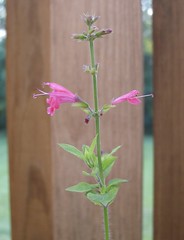
When we think of history, most of us think of books, historical documents and other text-based objects. If we want to get more inclusive, we might add "oral history" or storytelling, which is not tied to a piece of paper but is still conveyed in human words.
This blog's subject is the history of a part of the natural world, however. It's impossible for a human being to know if creatures we think of as part of "the natural world" have their own forms of history, but watching the ebb and flow of different organisms and habitats in a finite geographical area (like NJ) is history of a sort.
I'm a very novice gardener. I only have a deck to work with, which is home to various pots of herbs, vegetables and a few plants that I hope might attract some butterflies someday. The blossom that illustrates this post is from a Tropical Sage plant; it has just started blooming and with luck will continue blooming deep into fall. The plant has thrived this summer, despite its inauspicious origins from year-old seeds and sage's reputation for being difficult to grow from seed.
This plant is the direct descendant of an expanse of Tropical Sage plants in a yard in the Villas, Cape May County, that has attracted many rare hummers, including the Calliope Hummingbird that led me to visit the yard myself. While waiting for the bird to show up, I chatted with Jim Dowdell about various things, including gardening for hummers and butterflies. Jim was kind enough to give me some seeds from his Tropical Sage, and I finally got around to planting, a year late. It seems not to have mattered.
I'm not the sort of person who invites myself into other peoples' yards for good birds, even if permission has already been put out there on the hotline. I first met Jim when he was the proprietor of For the Birds, a nature store that some other veterans of Cape May in the 90s may remember. That made it easier to visit and chat for a shy person like myself.
So, this plant blooming on my deck and a Calliope Hummingbird that visited the Villas in late 2004 have a direct historical connection, as far as I'm concerned. That's no guarantee that another rare western hummer will visit my deck this fall, but it gives me a reason to smile when I look at the Tropical Sage, and that's good enough for me.